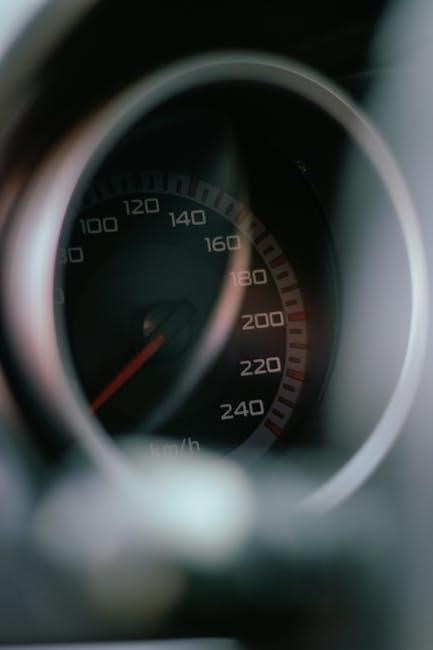Understanding speed, velocity, and acceleration is fundamental in physics, providing essential tools for analyzing motion. These concepts help describe how objects move and change their motion over time.
1.1 Importance of Understanding Motion Concepts
Mastering speed, velocity, and acceleration is crucial for analyzing motion in physics. These concepts form the foundation for understanding how objects move and change their motion over time. They are essential for solving real-world problems in engineering, sports, and everyday activities. By grasping these principles, students can interpret motion graphs, calculate distances, and predict future positions of objects. Understanding motion concepts also enhances problem-solving skills and logical thinking, making it vital for academic and professional success in science and technology fields.
1.2 Overview of the Worksheet and Its Purpose
This worksheet is designed to help students practice calculating speed, velocity, and acceleration using real-world problems. It includes a variety of questions that cover basic calculations, interpretation of motion graphs, and mixed motion scenarios. The worksheet aims to reinforce understanding of key formulas and concepts, such as distance-time graphs and speed-time graphs. By working through the exercises, students can improve their problem-solving skills and gain confidence in applying these principles to different situations. Detailed solutions are provided to facilitate self-assessment and learning.
Key Definitions and Concepts
Speed is a scalar quantity measuring distance over time. Velocity is a vector quantity incorporating both speed and direction. Acceleration is the rate of velocity change over time, also a vector quantity.
2.1 Speed: Definition and Formula
Speed is a scalar quantity representing the rate of change of distance over time. It is defined as the total distance traveled divided by the total time taken. The formula for speed is:
Speed (v) = Distance (s) / Time (t). Common units include meters per second (m/s) and kilometers per hour (km/h). Unlike velocity, speed does not consider direction, making it a simpler measure of motion. For example, a car traveling 120 km in 2 hours has a speed of 60 km/h. This concept is foundational for understanding more complex motion principles.
2.2 Velocity: Definition and Key Differences from Speed
Velocity is a vector quantity that describes the rate of change of an object’s position, considering both magnitude and direction. It is calculated using the formula:
Velocity (v) = Displacement (Δx) / Time (Δt). Unlike speed, which is scalar and only measures the rate of distance covered, velocity includes the direction of motion. For example, a car moving 30 m/s north has a velocity, while its speed is simply 30 m/s. This distinction makes velocity crucial for understanding an object’s movement in specific directions.
2.3 Acceleration: Definition and Formula
Acceleration measures the rate of change of velocity over time. It is a vector quantity, defined as:
Acceleration (a) = Change in Velocity (Δv) / Change in Time (Δt). Acceleration describes how an object’s speed or direction changes. The unit of acceleration is meters per second squared (m/s²). Positive acceleration indicates an increase in velocity, while negative acceleration indicates a decrease. For example, a car accelerating from 0 to 30 m/s in 5 seconds has an acceleration of 6 m/s². Understanding acceleration is crucial for analyzing motion in various physics and engineering problems.
Speed, Velocity, and Acceleration Problems
These problems involve calculating speed, velocity, and acceleration in various scenarios, such as constant motion, acceleration, and mixed motion. They help apply concepts to real-world situations.
3.1 Sample Problems with Solutions
Sample problems demonstrate practical applications of motion concepts. For instance, Pete drives 150 meters in 18 seconds; his speed is calculated as 8.33 m/s. A girl cycles 20 miles in 2 hours, achieving 10 mph. Another problem involves a car accelerating from 0 to 30 m/s in 6 seconds, resulting in an acceleration of 5 m/s². These examples, with step-by-step solutions, clarify how to apply formulas and interpret results accurately in various scenarios, ensuring a solid understanding of speed, velocity, and acceleration calculations.
3.2 Common Mistakes and Tips for Accuracy
Common mistakes include confusing speed and velocity, incorrect unit conversions, and misapplying formulas. Ensure proper unit consistency (e.g., meters vs. kilometers) and distinguish scalar speed from vector velocity. When calculating acceleration, avoid mixing time units (e.g., seconds vs. minutes). Always verify calculations and check for realistic results. Tips include reading problems carefully, labeling variables, and showing all steps. Practicing with sample problems helps build accuracy and confidence in solving motion-related questions effectively.

Worksheets and Practice Exercises
This section provides comprehensive worksheets covering speed, velocity, and acceleration calculations. Exercises include distance-time problems, mixed motion scenarios, and detailed answers for self-assessment and improvement.
4.1 Speed and Distance Calculations
These exercises focus on calculating speed using distance and time. Problems include scenarios like a girl cycling 20 miles in 2 hours, requiring the use of the formula speed = distance/time. Students are guided to show their work, ensuring understanding of unit conversions and the importance of accuracy. Answers are provided for each problem, allowing learners to verify their solutions and improve their problem-solving skills in physics.
4.2 Velocity and Acceleration Calculations
This section focuses on problems involving velocity and acceleration, essential for understanding motion dynamics. Velocity is calculated using displacement and time, while acceleration is derived from changes in velocity over time. Exercises include scenarios like a car accelerating from 0 to 60 mph, requiring the use of formulas such as velocity = displacement/time and acceleration = change in velocity/time. These problems help students grasp the relationship between these concepts and apply them to real-world situations, with answers provided for verification and learning.
4.3 Mixed Motion Problems
Mixed motion problems combine speed, velocity, and acceleration, challenging students to apply multiple concepts. These exercises often involve scenarios like objects moving with changing speeds or directions, requiring the use of various formulas. For instance, calculating the average velocity of a car accelerating and decelerating or determining the total distance traveled with varying accelerations. These problems enhance critical thinking and problem-solving skills, ensuring a deeper understanding of motion. Detailed solutions are provided to guide students through complex calculations and interpretations.
Graphical Analysis of Motion
Graphical analysis involves interpreting speed-time and distance-time graphs to understand motion. These visual tools help derive acceleration, velocity, and speed, providing insights into an object’s movement patterns.
5.1 Interpreting Speed-Time and Distance-Time Graphs
Speed-time graphs show an object’s speed over time, revealing acceleration when the slope changes. Distance-time graphs display position over time, indicating constant or variable speed. Both graphs provide visual representations of motion, allowing analysis of acceleration, deceleration, and constant velocity. By examining slopes and intercepts, one can calculate key motion parameters. These graphical tools are essential for understanding and predicting motion patterns, making them invaluable in physics and real-world applications.
5.2 Determining Acceleration from Graphs
Acceleration can be determined from graphs by analyzing the slope of speed-time or distance-time graphs. In a speed-time graph, acceleration is the gradient of the line, calculated as the change in speed over time. For distance-time graphs, acceleration is found by differentiating the slope twice. These graphical methods provide a visual understanding of how acceleration affects motion. By identifying steep or gradual slopes, one can infer the intensity of acceleration or deceleration, making graphs a powerful tool for motion analysis in physics and engineering.

Answers and Explanations
This section provides detailed solutions to practice problems, ensuring clarity and accuracy. It emphasizes the importance of correct units and proper calculation methods for motion analysis.

6.1 Detailed Solutions to Practice Problems
Detailed step-by-step explanations for each problem ensure understanding. Solutions include identifying variables, applying formulas, and calculating results with precise units. Examples cover speed, velocity, and acceleration calculations, addressing common errors and promoting accurate problem-solving skills. Each solution is structured to reinforce conceptual knowledge and practical application, making it easier for learners to grasp motion dynamics effectively. Clear explanations help students identify mistakes and improve their approach to physics problems.
6.2 Understanding Units and Their Importance
Units are crucial for accurate measurements and comparisons in physics. Common units for speed include meters per second (m/s) and miles per hour (mph). Velocity uses the same units but includes direction. Acceleration is measured in meters per second squared (m/s²). Consistent unit usage ensures clarity and avoids errors. Converting between units, such as kilometers per hour to meters per second, is often necessary. Proper unit application is essential for valid problem-solving and meaningful results in speed, velocity, and acceleration calculations.

Recommended Resources
Access worksheets and guides from Scribd, PhysicsAndMathsTutor, and other educational platforms for detailed practice and review of speed, velocity, and acceleration concepts.
7.1 PDF Worksheets with Answers
Premium resources like Scribd offer comprehensive PDF worksheets with answers, covering speed, velocity, and acceleration problems. These documents provide detailed solutions and explanations, enabling self-assessment and deeper understanding. They include a variety of question types, from basic calculations to complex motion scenarios. Worksheets are structured to align with curriculum standards, making them ideal for students and educators. Many resources are downloadable, allowing offline access for convenient practice. These PDFs are valuable tools for mastering motion concepts and preparing for exams or quizzes effectively.
7.2 Online Tools for Motion Calculations
Online tools like graphing calculators and simulation software simplify motion calculations. Websites offer interactive platforms for plotting speed-time and distance-time graphs, enabling visual analysis of motion. Additionally, online problem solvers provide step-by-step solutions for speed, velocity, and acceleration problems, making complex calculations more accessible. These tools are particularly useful for visual learners and those seeking to reinforce their understanding of motion concepts. Many are accessible directly through web browsers or mobile apps, offering convenience for students and educators alike.
